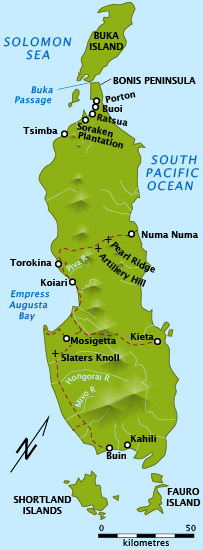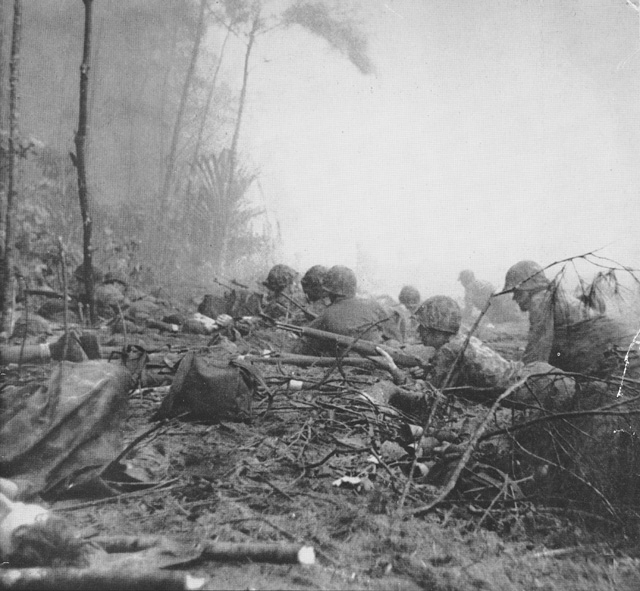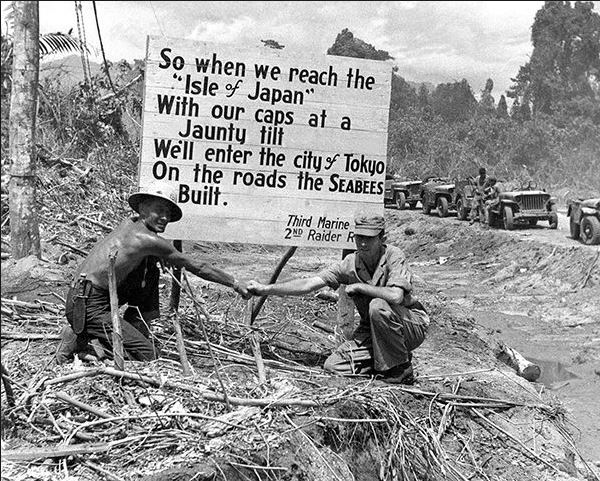|
Battle Of Empress Augusta Bay
The Battle of Empress Augusta Bay, on 1–2 November 1943 – also known as the Battle of Gazelle Bay, Operation Cherry Blossom, and in Japanese sources as the Sea Battle off Bougainville Island (ブーゲンビル島沖海戦) – was a naval battle fought near the island of Bougainville in Empress Augusta Bay. The naval battle was a result of Allied landings on nearby Bougainville in the first action in the Bougainville campaign of World War II and may also be considered as part of the Solomons and New Guinea campaigns. The battle was significant as part of a broader Allied strategy—known as Operation Cartwheel—aimed at isolating and surrounding the major Japanese base at Rabaul. The intention was to establish a beachhead on Bougainville, within which an airfield would be built. The naval battle took place at the end of the first day of the landings around Cape Torokina, as the Japanese sortied a large force from Rabaul in an effort to replicate the success they ha ... [...More Info...] [...Related Items...] OR: [Wikipedia] [Google] [Baidu] |
USS Columbia (CL-56)
USS ''Columbia'' (CL-56) was one of 27 United States Navy light cruisers completed during or shortly after World War II. The ship, the sixth US Navy ship to bear the name, was named for the city of Columbia, South Carolina. ''Columbia'' was commissioned in July 1942, and saw service in several campaigns in the Pacific. Like almost all her sister ships, she was decommissioned shortly after the end of the war, and never saw active service again. ''Columbia'' was scrapped in the early 1960s. A memorial to the ship and men who served on her exists in Columbia, SC. Construction and commissioning ''Columbia'' was laid down on 19 August 1940 by the New York Shipbuilding Corp., Camden, New Jersey; and launched on 17 December 1941 sponsored by Miss J. A. Paschal. She was commissioned on 29 July 1942, with Captain (naval), Captain W. A. Heard in command. Service history World War II 1942-43 Sailing from Norfolk on 9 November 1942, ''Columbia'' arrived at Espiritu Santo, New Hebrides o ... [...More Info...] [...Related Items...] OR: [Wikipedia] [Google] [Baidu] |
New Guinea Campaign
The New Guinea campaign of the Pacific War lasted from January 1942 until the end of the war in August 1945. During the initial phase in early 1942, the Empire of Japan invaded the Australian-administered Mandated Territory of New Guinea (23 January) and the Australian Territory of Papua (21 July) and overran western New Guinea (beginning 29/30 March), which was a part of the Netherlands East Indies. During the second phase, lasting from late 1942 until the Japanese surrender, the Allies—consisting primarily of Australian forces—cleared the Japanese first from Papua, then the Mandate and finally from the Dutch colony. The campaign resulted in a crushing defeat and heavy losses for the Empire of Japan. As in most Pacific War campaigns, disease and starvation claimed more Japanese lives than enemy action. Most Japanese troops never even came into contact with Allied forces, and were instead simply cut off and subjected to an effective blockade by Allied naval forces. Garrison ... [...More Info...] [...Related Items...] OR: [Wikipedia] [Google] [Baidu] |
Bernard L
Bernard (''Bernhard'') is a French and West Germanic masculine given name. It is also a surname. The name is attested from at least the 9th century. West Germanic ''Bernhard'' is composed from the two elements ''bern'' "bear" and ''hard'' "brave, hardy". Its native Old English reflex was ''Beornheard'', which was replaced by the French form ''Bernard'' that was brought to England after the Norman Conquest. The name ''Bernhard'' was notably popular among Old Frisian speakers. Its wider use was popularized due to Saint Bernhard of Clairvaux (canonized in 1174). Bernard is the second most common surname in France. Geographical distribution As of 2014, 42.2% of all known bearers of the surname ''Bernard'' were residents of France (frequency 1:392), 12.5% of the United States (1:7,203), 7.0% of Haiti (1:382), 6.6% of Tanzania (1:1,961), 4.8% of Canada (1:1,896), 3.6% of Nigeria (1:12,221), 2.7% of Burundi (1:894), 1.9% of Belgium (1:1,500), 1.6% of Rwanda (1:1,745), 1.2% of Germany ( ... [...More Info...] [...Related Items...] OR: [Wikipedia] [Google] [Baidu] |
6"/47 Caliber Mark 16 Gun
The 6-inch/47 caliber Mark 16 gun was used in the main batteries of several pre-war and World War II US Navy light cruisers. They were primarily mounted in triple turrets and used against surface targets. The Mark 16DP gun was a dual purpose fitting of the Mark 16 for use against aircraft as well as surface ships. It was installed in the post-war light cruisers and the anti-aircraft gunnery training ship . The Mark 17 gun was a variation of the Mark 16 to use bagged charges; this was only used in the in a single pedestal mount. Design Three versions of this breech loading rifled naval gun were produced, the 6-inch/47 Mark 16 Mod 0, the 6-inch/47 Mark 16 Mod 1, and 6-inch/47 Mark 17. "6-inch /47" refers to a bore diameter (caliber) of and a bore length of 47 calibers (ie 47 x 6 inch; . "Mark 16" indicates it is the 16th design in the series of US Navy 6-inch guns. "Mod 0" or "Mod 1" indicates minor modifications to the design, with 0 being the original and 1 being the first ... [...More Info...] [...Related Items...] OR: [Wikipedia] [Google] [Baidu] |
Battle Of Koromokina Lagoon
The Battle of the Koromokina Lagoon was fought between the United States Marine Corps and Imperial Japanese Army forces on Bougainville Island. It took place on 7–8 November 1943 during the Bougainville campaign. In response to the Allied landings on Bougainville at Cape Torokina, Japanese General Hitoshi Imamura, commander of the 8th Area Army at Rabaul, determined to launch a counterattack. Underestimating the size of the Allied landing forces, the Japanese dispatched a force of 850 soldiers to execute a counter landing to attempt to drive the Allied forces back into the sea. The Japanese soldiers landed from four destroyers near Koromokina Lagoon on the night of 7 November and engaged two battalions of U.S. Marines from the 3rd and 9th Marine Regiments under the command of Major General Allen H. Turnage. Over the next two days the Japanese attacks were defeated with heavy losses to the attackers. After the battle, Allied forces continued to expand their beachhead on Bougain ... [...More Info...] [...Related Items...] OR: [Wikipedia] [Google] [Baidu] |
Morikazu Osugi
Morikazu (written: 盛和 or 守一) is a masculine Japanese given name A given name (also known as a forename or first name) is the part of a personal name quoted in that identifies a person, potentially with a middle name as well, and differentiates that person from the other members of a group (typically a fa .... Notable people with the name include: * (1843–1890), Japanese politician and journalist * (1917–2010), Japanese physicist {{given name Japanese masculine given names Masculine given names ... [...More Info...] [...Related Items...] OR: [Wikipedia] [Google] [Baidu] |
Location Of Bougainville
In geography, location or place are used to denote a region (point, line, or area) on Earth's surface or elsewhere. The term ''location'' generally implies a higher degree of certainty than ''place'', the latter often indicating an entity with an ambiguous boundary, relying more on human or social attributes of place identity and sense of place than on geometry. Types Locality A locality, settlement, or populated place is likely to have a well-defined name but a boundary that is not well defined varies by context. London, for instance, has a legal boundary, but this is unlikely to completely match with general usage. An area within a town, such as Covent Garden in London, also almost always has some ambiguity as to its extent. In geography, location is considered to be more precise than "place". Relative location A relative location, or situation, is described as a displacement from another site. An example is "3 miles northwest of Seattle". Absolute location An absolute locatio ... [...More Info...] [...Related Items...] OR: [Wikipedia] [Google] [Baidu] |
Rear Admiral (United States)
A rear admiral in the uniformed services of the United States is either of two different ranks of commissioned officers: one-star flag officers and two-star flag officers. By contrast, in most other countries, the term " rear admiral" refers only to an officer of two-star rank. Rear admiral (lower half) Rear admiral (lower half) (abbreviated as RDML), is a one-star flag officer, with the pay grade of O-7 in the United States Navy, the United States Coast Guard, the United States Public Health Service Commissioned Corps, and the National Oceanic and Atmospheric Administration Commissioned Officer Corps. Navy: grades above chief warrant officer, W–5 Grades and ratings Pay grades: assignment to; general rules Rear admiral (lower half) ranks above captain and below rear admiral. Rear admiral (lower half) is equivalent to the rank of brigadier general in the United States Army, Air Force, Marine Corps, and Space Force and equivalent to the rank of commodore in most other navie ... [...More Info...] [...Related Items...] OR: [Wikipedia] [Google] [Baidu] |
Seventeenth Army (Japan)
The was an army of the Imperial Japanese Army during World War II. History The army was formed on May 18, 1942 under the Japanese Eighth Area Army of the Southern Expeditionary Army Group for the specific task of opposing landings by Allied forces in Japanese-occupied Solomon Islands. It was initially headquartered on Rabaul and participated in the Guadalcanal and New Guinea campaigns of the South West Pacific theatre of World War II. After General Hitoshi Imamura took over command of the Japanese Eighth Area Army the 17th Army was responsible primarily for the defense of Bougainville. It was trapped and cut off from reinforcements and re-supply during the Bougainville campaign (1943–45) The Bougainville campaign was a series of land and naval battles of the Pacific campaign of World War II between Allied forces and the Empire of Japan, named after the island of Bougainville. It was part of Operation Cartwheel, the Allied ..., and was forced to live off the land ... [...More Info...] [...Related Items...] OR: [Wikipedia] [Google] [Baidu] |
Landings At Cape Torokina
The Landings at Cape Torokina (1–3 November 1943), also known as Operation Cherryblossom, took place at the beginning of the Bougainville campaign in World War II. The amphibious landings were carried out by elements of the United States Marine Corps in November 1943 on Bougainville Island in the South Pacific, as part of Allied efforts to advance towards the main Japanese base around Rabaul under Operation Cartwheel. Coming in the wake of Allied successes at Guadalcanal and in the central Solomons, the landings were intended to secure a beachhead with the purpose of establishing several bases from which to project air and naval power closer towards Rabaul, in an effort to neutralize the large Japanese force that had been established there. In the months leading up to the operation, Japanese airpower on Bougainville was degraded by Allied air strikes, while small parties of Allied reconnaissance forces landed around Bougainville and the surrounding islands to gather intelli ... [...More Info...] [...Related Items...] OR: [Wikipedia] [Google] [Baidu] |
3rd Marine Division (United States)
The 3rd Marine Division is a division (military), division of the United States Marine Corps based at Camp Courtney, Marine Corps Base Camp Smedley D. Butler in Okinawa Prefecture, Okinawa, Japan. It is one of three active duty infantry divisions in the Marine Corps and together with the 1st Marine Aircraft Wing (1stMAW) and the 3rd Marine Logistics Group (3rd MLG) forms the III Marine Expeditionary Force (III MEF). The division was first formed during World War II and saw four years of continuous combat in the Vietnam War. Today, elements of the 3rd Marine Division are continuously forward deployed and forward postured to carry out the US Government's mission of a Free and Open Indo-Pacific in conjunction with its sister services. Subordinate units * List of Marine Corps battalions#Headquarters battalions, Headquarters Battalion * 3rd Marine Littoral Regiment * 4th Marine Regiment (United States), 4th Marine Regiment (Infantry) * 12th Marine Regiment (United States), 12th M ... [...More Info...] [...Related Items...] OR: [Wikipedia] [Google] [Baidu] |
Battle Of Savo Island
The Battle of Savo Island, also known as the First Battle of Savo Island and, in Japanese sources, as the , and colloquially among Allied Guadalcanal veterans as the Battle of the Five Sitting Ducks, was a naval battle of the Solomon Islands campaign of the Pacific War of World War II between the Imperial Japanese Navy and Allied naval forces. The battle took place on August 8–9, 1942, and was the first major naval engagement of the Guadalcanal campaign, and the first of several naval battles in the straits later-named Ironbottom Sound, near the island of Guadalcanal. The Imperial Japanese Navy, in response to Allied amphibious landings in the eastern Solomon Islands, mobilized a task force of seven cruisers and one destroyer under the command of Vice Admiral Gunichi Mikawa. The task forces sailed from Japanese bases in New Britain and New Ireland down New Georgia Sound (also known as "the Slot"), with the intention of interrupting the Allied landings by attacking th ... [...More Info...] [...Related Items...] OR: [Wikipedia] [Google] [Baidu] |


.jpg)



_underway_off_Tulagi%2C_circa_7_August_1942.jpg)